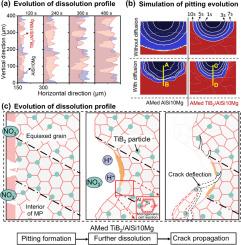原位TiB2纳米颗粒可以实现均匀的电化学溶解,提高增材制造的微内通道的尺寸精度和毛细性(Φ 1.4 mm)。
IF 14.3
1区 材料科学
Q1 MATERIALS SCIENCE, MULTIDISCIPLINARY
引用次数: 0
摘要
电化学抛光(ECP)本身无法克服复杂增材制造(AMed)零件的内表面粗糙度和尺寸精度的限制,这突出了基于材料的改进的必要性。在这里,我们报告了一种纳米颗粒驱动的AMed合金,它本质上促进了均匀的电化学溶解。通过计算机断层扫描(CT)切片分析、原位同步x射线成像和电化学溶解过程的模拟,我们发现TiB2纳米颗粒的晶粒细化和腐蚀裂纹偏转效应是改善均匀溶解的原因。晶界密度的增加和晶粒尺寸的减小导致了更随机的晶体取向和均匀化的熔池(MP)中与晶粒相关的腐蚀电位。随着深度电位变化的减小,扩散控制溶蚀,加上横向腐蚀裂纹扩展的增强,显著提高了AMed tib2 /AlSi10Mg的溶蚀均匀性。经过ECP处理后,与AlSi10Mg热管相比,AMed TiB2/AlSi10Mg热管(Φ 1.4 mm)的内表面粗糙度从5.4 μm降低到2.2 μm,圆度公差从59 μm降低到31 μm。此外,毛细管作用增加218%,表明传热性能增强,支持更广泛的应用-在其他复杂的AMed材料和结构中的特定性能和功能。本文章由计算机程序翻译,如有差异,请以英文原文为准。

In situ TiB2 nanoparticles enable uniform electrochemical dissolution for enhanced dimensional precision and capillarity in additively manufactured micro inner channels (Φ 1.4 mm)
Electrochemical polishing (ECP) alone cannot overcome the limitations in inner surface roughness and dimensional accuracy imposed by heterogeneous dissolution behaviors in complex additively manufactured (AMed) parts, highlighting the need for material-based improvements. Here, we report a nanoparticle-enabled AMed alloy that intrinsically promotes uniform electrochemical dissolution. Using computed tomography (CT) slices analysis, in situ synchrotron X-ray imaging, and stimulation of the electrochemical dissolution process, we reveal that the improved uniform dissolution arises from grain refinement and corrosion crack deflection effects induced by in situ TiB2 nanoparticles. The resulting increase in grain boundary density and reduction in grain size lead to a more randomized crystallographic orientation and a homogenized grain-related corrosion potential across the melt pool (MP). The decreased potential variation in depth, diffusion-controlled dissolution, coupled with enhanced lateral corrosion crack propagation, significantly improves dissolution uniformity in AMed TiB₂/AlSi10Mg. After ECP, the AMed TiB2/AlSi10Mg heat pipes (Φ 1.4 mm) exhibit a reduction in inner surface roughness from 5.4 to 2.2 μm and in roundness tolerance from 59 to 31 μm, relative to the as-built AlSi10Mg counterpart. Moreover, a 218% increase in capillary action suggests enhanced heat transfer performance, supporting broader applications – specific performance and functionality in other complex AMed materials and structures.
求助全文
通过发布文献求助,成功后即可免费获取论文全文。
去求助
来源期刊

Journal of Materials Science & Technology
工程技术-材料科学:综合
CiteScore
20.00
自引率
11.00%
发文量
995
审稿时长
13 days
期刊介绍:
Journal of Materials Science & Technology strives to promote global collaboration in the field of materials science and technology. It primarily publishes original research papers, invited review articles, letters, research notes, and summaries of scientific achievements. The journal covers a wide range of materials science and technology topics, including metallic materials, inorganic nonmetallic materials, and composite materials.
 求助内容:
求助内容: 应助结果提醒方式:
应助结果提醒方式:


